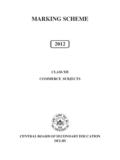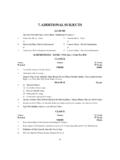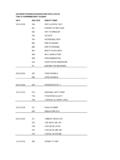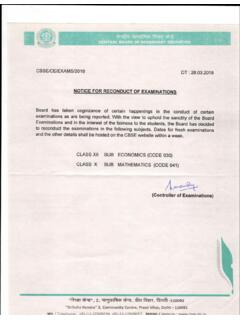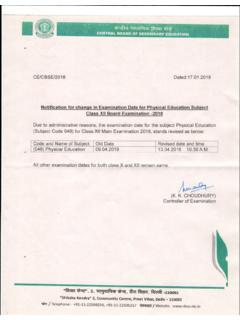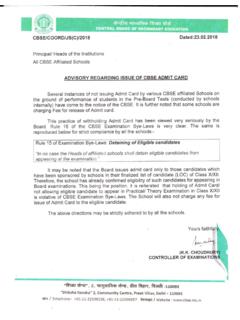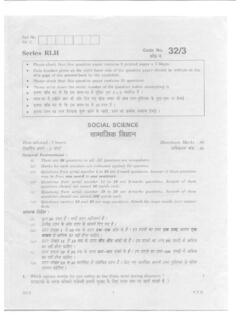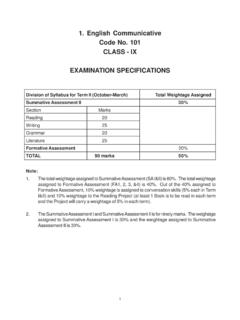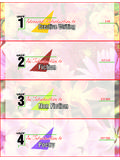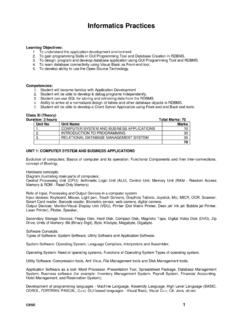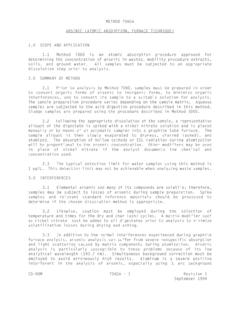Transcription of Formative Assessment Manual for Teachers Light ...
1 121 Formative Assessment Manual for Teachers Light : Reflection and Refraction - chapter 10 Complete the inference statements, based on your interpretation of the data collecter by you, for a concave lens a. the image is always .. in nature. b. The image moves ..(nearer/away).. to /from the focus as the object is moved progressively closer to the optical centre. c. The image size keeps on progressively ..(decreasing/increasing) .. as the object is moved progressively away from the focus. d. For all object distances less than the focal length, the image is ..(diminished/magnified) .. with respect to the Remediation :The teacher may guide students about Choosing an appropriate scale in each situation Drawing to the scale ray diagrams Observing any regularity/pattern present is a (given) data Drawing conclusions on the basis of the observed regularity/pattern in the (given) data.
2 [Note: The focal length magnitude , object size and object distances values given are only Suggested in nature and the teacher can make appropriate changes is them for assigning work to different students.]122 chapter 11 - Human Eye and Colourful World Formative Assessment Manual for TeachersHuman Eye and Colourful World chapter 11 Assessment Technique: Application based work : To enable the student to learn about the approximate size (say, r,) of the (normal) eye-ball that, in case of human eye, the distance between the screen (the retina) and the eye-lens remains (nearly) fixed irrespective of the distance of the object That during normal relaxed vision, u = and v = r. That for u 25cm, and v = r, the eye is looking at an object kept at the least distance of distinct vision. That the amazing power of accommodation of the human eye does not really involve a very large percentage change in the focal length of the : Individual numerical problemAssesment time: 20 MinutesProcedure Task : The teacher may explain to the students that: size of the normal eye-ball may be taken as close to object distance, during normal relaxed vision, of very far off objects, is infinite.
3 Minimum object distance, during the seeing of nearby objects, has to be (nearly) 25cm for the normal eye. Lens formula can be used to calculate the focal length of the eye-lens both for far-off and for near viewing. Power of a lens (in diopters) equals the reciprocal of the focal length (in meters). Assessment Parameters : 1 mark for each correct WorksheetInstructions : You are given that the size of the normal eyeball is nearly 2cm and the normal eye can adjust the focal length of its eye-lens to see objects situated anywhere from 25cm to an infinite distance away from itNow answer the following questions:1. What is the focal length (in metres) of the (normal) eye-lens when it is viewing a very far off object ?2. What is the power of the eye-lens in this case ?3. A normal eye is viewing an object kept 25cm away from it.
4 What is the focal length of the eye-lens in this case ?4. What is the power of the eye-lens for this (normal) near-viewing?123 Formative Assessment Manual for Teachers Human Eye and Colourful World - chapter 115. How much is the percentage change, in the focal length of the eye-lens, when it adjusts itself, from its normal relaxed position, to the position where the eye can see the near-by object clearly?Suggested Remediation: Some of the students may not understand that the size of the eye-ball is equal to the image distance irrespective of the position of the teacher may help the students realize that in the case of the human eye, the distance between the lens and the screen (the retina) remains fixed and that this distance is (nearly) equal to the size of the eye-ball. use lens formula = f1u1v1 to calculate the focal length of the eye-lens for both (i) very far off (ii) normal near viewing.
5 Calculate the percentage change in the focal length of the eye-lens and appreciate that it is not a very large change. appreciate the wonderful capacity of the human eye its amazing 'power of accommodation'Human Eye and Colourful World chapter 11 Assessent Technique: Individual WorksheetObjective : To enable the learner to get familiar with some natural phenomenon based on the dispersion of Light . places, time and situations under which these phenomenon are best observed The ways and means of presenting these observed phenomenon through suitable drawings/paintings/photographs Assessment Task: Listing, Recapitulation, DrawingProcedure : The teacher may discuss with the students about some natural phenomenon like the rainbow, the red colour of sky at sunset and sunrise times, the blue of sky - based on the multicolored nature of sun Light .
6 About cause/s reflection, refraction, total internal reflection, scattering that are associated with these different phenomenon. to look for other interesting natural phenomenon through surfing the net, talking with seniors, reading from books that are associated with the multicoloured nature of white Light . record their interesting observations through suitable (coloured) drawings/paintings/photographs 11 - Human Eye and Colourful World Formative Assessment Manual for Teachers to try and visit places, far from the haze and dust of crowded cities, for a clearer and better observation of these natural Parameters : Two marks for listing of natural phenomenon One mark for the recapitulation of the place or (approximate) time of their observations Two marks for (at least one) drawing/painting/photograph of the natural phenomenon WorksheetInstructions: Do as directed:1.
7 Make a list of the natural phenomenon associated with the multicoloured nature of white When and where did you observe/last observe (any one/some of) the phenomenon listed above?3. Draw a drawing or make/collect a painting or give your own/otherwise available photograph of the natural phenomenon that you liked and appreciated the Remediation : Some of the students may not be keen to study the phenomenon and collect relevant information/pictures of the same. The teacher may aruse their curiosity by explosive them to the wonderful world of natural phenomenon like the rainbow, the red-colour of the sky at sun-rise and sun-set, the blue of the sky and so on. The teacher may also collect information- to the extent possible from the net, books, newspaper and magazine reports about some not so common phenomenon, based on the multicoloured nature of sunlight.
8 The teacher may encourage and motivate her/his students to appreciate the boundless beauties and wonders of nature and to do their best to cause least damage to nature and natural Human Eye and Colourful World chapter 11 Assessment Technique: Matching Type WorksheetObjectives : To enable the learner to Understand the structure of the human eye. Correlate the parts of the human eye to their practical Assessment Manual for Teachers Human Eye and Colourful World - chapter 11 Study the types of defects in the human eye and their correction. Differentiate between the main defects of the eye and to investigate their cause/s. Appreciate the role of ciliary muscles and correcting lenses (when needed) to get a clear vision of the objects situated anywhere between 25 cm to Time : 15 minutesProcedure : The teacher may Describe the structure of the eye using a labeled diagram Discuss the function of different parts of the eye Explain the types of defects of vision and their cause/s.
9 Discuss the location of near point/far point of defective eye and compare the same with those of a normal eye. Describe how the use of lenses helps in correction of eye parameters : Half mark for each correct WorksheetInstructions :The following table lists a few functions/phrases/statements in column A. Match these items in column A to the corresponding terms in column B. Note that more than one item in column A may match with the same item in column matching for A1 and A2 is given as an AColumn BA1 Light -sensitive screenB1 HypermetropiaA2 Cells on this part generate electrical signals upon illuminationB2 RetinaA3 Near-sightednessB3 DeviationA4 Corrected by using bifocal lensesB4 MyopiaA5 Inability to see nearby objects clearlyB5 Ciliary muscelsA6 With objects at 25cm, the image is formed behind the retinaB6 Increased focal length of the eye-lensA7 Modify the curvature of the eye-lens B7 PresbyopiaA8 Milky and cloudy eye-lensB8 Cataract126 chapter 11 - Human Eye and Colourful World Formative Assessment Manual for TeachersColumn AColumn BA9 Near point of the eye moves awayB9 Reddish colour of the skyA10 Distance of the far point decreasesB10 Scattering of lightA11 Corrected by a converging lensB11 RefractionA12 Corrected by a concave lensB12 Scattering of lightA13 Relaxed ciliary musclesB13 Twinkling of starsA14 Difficulty in reading blackboard while sitting in the last Caused by excessive curvature of the eye lensB15 Increase in size of the eye-ballA16 Caused by increased focal length of the eye lensB16 decrease in size of the Caused by Light passing through thinner layers
10 Of airA18 Makes the sky appear bluishA19 The band of coloured components of white lightA20 The phenomenon causing advanced sunrise and delayed Caused by changing physical conditions of the atmosphereA22 Angle formed between the incident ray and the emergent ray in a [A1, B2] A1B2A22. [A2, B2]Suggested Remediation: Some of the students tend to omit the detailed functioning of some parts of the human eye. The detailed functions of each part how a ciliary muscle controllers the focal length/curvature of he eye in relaxed/compressed position, should be highlighted. The correction of eye defects, requires the detailed study of each of the defects of the human eye. Their causes, their effect on near point/far point and role of the correcting lenses should be discussed in detail and supported with relevant ray Assessment Manual for Teachers Human Eye and Colourful World - chapter 11 Human Eye and Colourful World chapter 11 Assessment Technique Diagram based worksheetObjectives: To enable the students to Learn the function of the lens in a human eye.
